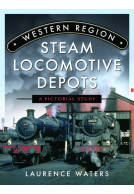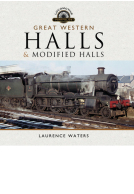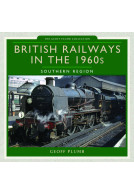Railways of Oxford (Hardback)
A Transport Hub that Links Britain
Imprint: Pen & Sword Transport
Pages: 224
Illustrations: 200 colour & black and white illustrations and maps
ISBN: 9781526740380
Published: 9th November 2020
(click here for international delivery rates)
Order within the next 11 hours, 8 minutes to get your order processed the next working day!
Need a currency converter? Check XE.com for live rates
| Other formats available - Buy the Hardback and get the eBook for £1.99! | Price |
|---|---|
| Railways of Oxford ePub (78.7 MB) Add to Basket | £9.98 |
This is a history of the railways of Oxford ,looking at the operations and development of services , from the opening of the Oxford Railway by the Great Western on 12 June 1844 through to the present day. This volume covers the development of the railway locally, including the London and North Western ‘Buckinghamshire Railway’ from Bletchley, together with the five local branch lines.
The opening of the Great Western / Great Central joint line from Culworth Junction to Banbury Junction in August 1900 resulted in the growth of inter regional ‘cross country' services passing through Oxford .
The advent of the Second World War saw the construction of a new junction at Oxford North, giving for the first time a direct link from the Great Western to the London Midland & Scottish Railway branch to Bletchley and beyond.
The opening of these two new junctions saw a considerable increase in both passenger and freight traffic, which resulted in Oxford becoming a major railway centre . For many years one of the highlights was the arrival and departure of locomotives on a daily basis from all of the big four railway companies. Those days are long gone, but today Oxford is as busy as ever, with passenger services to London operated by Great Western Railway and Chiltern Trains, and by Cross Country Trains to the south and the north of England.
The book is copiously illustrated with some particularly good images from the C19 and early C20. The author is honourary photographic archivist to the Great Western Trust at Didcot Railway Centre and his knowledge of early railway photography is unsurpassed.
Oxfordshire Local History Vol.10 No. 4
Review as featured in
Rail Express
The book, written by well known railway author, Laurence Waters, has been produced in a handy size and within its 224 pages and eight chapters, succinctly covers what at times, was a complicated history of the railways in and around the city of Oxford.
Richard Abbey - 6024 Preservation Society
Taking the reader from the early history of the Oxford branch promoted by Brunel, the trials and tribulations of 'Town and Gown' (Similar to those the great man faced with Eaton College) to the opening in 1844. From then on, other companies saw Oxford as a worthy goal or as part of a route avoiding the GWR broad gauge monopoly to London, indeed with trains running to the LNWR terminus at Euston. Subsequent chapters indeed cover the LNWR and their adjacent Rewley Road station, whilst a further chapter covers the main GWR station in some depth.
The author then strikes out on to cover the immediate branch lines which fed in to the mainline, covering each well before looking at the Engine sheds, Goods department and passenger services. The whole is well illustrated with both period (some in colour) and more modern views, covering the ever changing scene. Some of those taken in the last 10-15 years, show liveries which themselves, are now memories so fast are the changes .Some of the steam era photographs I had not seen before and is testament to the authors ability to source illustrations from the vast archive held by the Great Western Railway Society at their Didcot headquarters.
The book is written in an easy to read and understand style and seems to have been well edited and proof read which makes a refreshing change these days, my only comment is with regard to the caption to the upper photograph on page 127 it not being a parcel wagon, but a horse box.
An excellent record of both the lost and current railway scene in the 'City of Spires' and to be recommended.
This is a beautifully presented book printed on glossy paper and illustrated by many quality black and white and colour images, featuring not only trains but a selection of early large scale Ordnance Survey maps, historic handbills and notices. For those wanting a concise and very readable account of Oxford’s railways through the years, this book is sure to find a place on their shelves.
West Somerset Railway Association
Featured in
Diesel and Electric Modellers United, Issue 96
Return trip to days when city provided railway hub
Oxford Mail 10/05/21
Featured in
The Oxfordshire Family Historian, April 2021 - Oxfordshire Family History Society
Featured in the
Journal of the Railway & Canal Historical Society
Passing through Oxford station many times I never thought of it as a railway hub. The author makes a good case in a well-informed and properly presented book. Oxford’s railway history was more complex than appears at first sight. Lines included the “Old, Worse and Worse”, the Great Western and the London and North Western Railways. Plans for a Great Western carriage and wagon works was stymied but Morris Motors traffic became important. There were attractive branch lines within easy reach of Oxford and these also feature. This is a worthwhile book confirming Oxford‘s place in Britain’s railways and that it was far more than just “dreaming spires”.
Roger Backhouse, The Society of Model and Experimental Engineers Journal
With so much information and photos, this book is not just for rail enthusiasts, but if you have an interest in local history, this is great to see how the railways helped Oxford to develop into what it is today.
Rail Advent
Read the full review here
This book is flavour of the branch lines around Oxford. Excellent book
James Simmonds
About Laurence Waters
Laurence Waters has written a number of books for Pen and Sword and is a well known railway historian of Great Western subjects. The Author has had a life long interest in the history and operation of the railway in Oxford . This book on the history of the railways in Oxford is his latest work, and covers the growth of the railway and its effect on the economic and social development of the area.
He lives in Oxford and is the honorary photographic archivist for the Great Western Trust at Didcot Railway Centre.
He has been instrumental in saving a number of important photographic collections for the Great Western Trust and currently leads a small team of volunteers who research and catalogue the ever increasing collection of images being donated to the Trust’s archive.






















